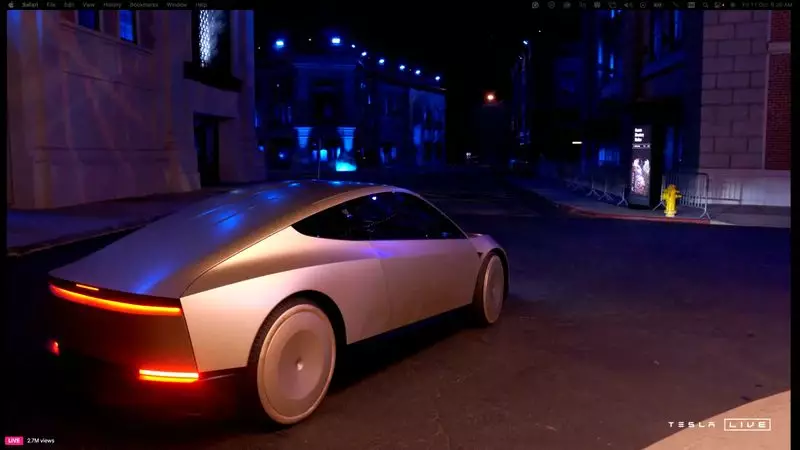At a recent event that drew considerable attention from both fans and skeptics alike, Elon Musk, the CEO of Tesla, presented his long-awaited vision for the future of urban transportation: the autonomous robotaxi, known as the Cybercab. With its distinctive gull-wing doors and absence of traditional controls like steering wheels or pedals, the Cybercab epitomizes a bold, futuristic leap for the electric vehicle manufacturer. Musk announced that production of this innovative vehicle is scheduled to commence in 2026, with an ambitious pricing strategy aiming to keep it below $30,000. He enthused that operating costs would be a mere 20 cents per mile, fostering the potential for widespread adoption.
Musk’s assertion that “the vast majority of the time, cars are just doing nothing” encapsulates the crux of his vision. By transforming the idea of vehicle ownership into a shared, autonomous experience, he posits that the utility of cars can be multiplied significantly, potentially by five to ten times. This vision rests on the premise that autonomous vehicles can increase efficiency in urban transport, alleviating congestion and minimizing the environmental impact of personal vehicle use.
While Musk’s announcement has sparked enthusiasm on social media platforms, it is imperative to temper this excitement with a dose of realism. Investors and analysts have voiced their concerns regarding the technological hurdles Tesla must overcome to realize this vision. For instance, although Musk has characterized Tesla as an “AI robotics company,” the complexities of developing fully autonomous vehicles cannot be understated. The event, aptly titled “We, Robot,” not only references the legacy of Isaac Asimov but also highlights the challenges Tesla faces in shifting perceptions from a traditional automaker to a leader in AI and robotics.
Attendees, which included prominent figures such as Stellantis’ chairman John Elkann, were eager to glean insights about the feasibility of scaling production, cost efficiency, and, most critically, profitability in the robotaxi market. With the looming question of how Tesla will match or surpass competitors like Alphabet’s Waymo—who have already deployed uncrewed robotaxis in select U.S. cities—investors are on high alert for Musk to present concrete plans and timelines.
Despite the glimmering allure of the Cybercab, one cannot overlook the missed promises that have defined Musk’s previous ventures in autonomous driving technology. In 2019, he confidently predicted that operational robotaxis would be a reality by 2020. Fast-forward to the present, and the timeline has stretched considerably while several high-profile plans have been scrapped in light of slow EV demand.
Tesla’s predicament is further complicated by a potential downturn in deliveries for the year, marked by persistent challenges in enticing customers with its aging electric vehicle lineup. Recent aggressive price cuts aimed at offsetting high interest rates have further strained profit margins, and observers are left wondering how Musk will reassure investors of continued growth amidst these complications.
Analysts assert that the path to restoring investor confidence hinges on showcasing tangible progress in producing the Cybercab, especially in the face of a competitive landscape. Other major players, including General Motors’ Cruise and Amazon’s Zoox, have made significant investments in the robotaxi space but have duly noted the high stakes, with many companies experiencing substantial financial losses due to the complexities and regulatory scrutiny surrounding autonomous driving.
FSD Technology Under Fire
Central to Musk’s proposition is the reliance on the Full Self-Driving (FSD) system, which he plans to utilize for Cybercabs. Unlike competitors who lean heavily on advanced hardware like lidar systems, Musk is banking on the capabilities of cameras and AI to underpin a cost-effective solution. However, this approach is not without its controversies. The FSD system has faced regulatory hurdles and legal challenges, particularly in light of several fatal incidents linked to its operation.
As Tesla charges ahead with its robotaxi ambitions, the road ahead is laden with uncertainty. The challenges surrounding technology development, investor expectations, and regulatory compliance could either propel Tesla into a new era of transportation innovation or serve as a stumbling block for its aspirations. The coming years will be crucial for sorting fact from fiction in Musk’s bold ambitions for the Cybercab. As the unveiling event leaves spectators buzzing, the real questions linger: Can Tesla truly transform the landscape of transportation with robotaxis, or will this venture become another ambitious dream deferred?

